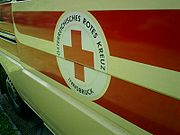
Austrian Red Cross
Encyclopedia

Austria
Austria , officially the Republic of Austria , is a landlocked country of roughly 8.4 million people in Central Europe. It is bordered by the Czech Republic and Germany to the north, Slovakia and Hungary to the east, Slovenia and Italy to the south, and Switzerland and Liechtenstein to the...
and is part of the International Red Cross and Red Crescent Movement
International Red Cross and Red Crescent Movement
The International Red Cross and Red Crescent Movement is an international humanitarian movement with approximately 97 million volunteers, members and staff worldwide which was founded to protect human life and health, to ensure respect for all human beings, and to prevent and alleviate human...
. It was established on March 14, 1880 by Doctor Adam Lichtenheld of the Vienna General Hospital
Vienna General Hospital
The Vienna General Hospital is the University medical center of the city of Vienna, Austria. The AKH is the largest hospital of Austria and Europe, the second largest hospital in the world, and at 85-m high is one of the tallest hospital buildings in the world...
and is the biggest aid agency
Aid agency
An aid agency is an organisation dedicated to distributing aid. Many professional aid organisations exist, both within government , between governments as multilateral donors and as private voluntary organizations...
in the country.
Duties
Its duties contain:- Emergency medical servicesEmergency medical servicesEmergency medical services are a type of emergency service dedicated to providing out-of-hospital acute medical care and/or transport to definitive care, to patients with illnesses and injuries which the patient, or the medical practitioner, believes constitutes a medical emergency...
and transport services, being the dominating provider in most parts of Austria - Blood-donation-service - 95% of the donated blood is provided by the Red Cross
- Social- and healthcare programs
- Development Cooperation, Rehabilitation and Emergency Aid
- Educational service (first aid courses)
- International Tracing ServiceInternational Tracing ServiceThe International Tracing Service in Bad Arolsen, Germany, is the internationally governed archive whose task it is to document the fate of millions of civilian victims of Nazi Germany. The documents in the ITS archives include original records from concentration camps, details of forced labour,...
- After WWII and nowadays after big disasters. - Supervision of international humanitarian lawInternational humanitarian lawInternational humanitarian law , often referred to as the laws of war, the laws and customs of war or the law of armed conflict, is the legal corpus that comprises "the Geneva Conventions and the Hague Conventions, as well as subsequent treaties, case law, and customary international law." It...
Most employees are volunteers, in the year 2004 45.000 were counted.
Presidents of the ÖRK
- Karl Baron of Tinti (1880–1884)
- Franz Earl Falkenhayn (1885–1898)
- Prince Alois von Schönburg-HartensteinAlois Schönburg-HartensteinAlois Schönburg-Hartenstein, was a military officer in the Austro-Hungarian army and as a Prince of Schönburg-Hartenstein, a member of the Austrian nobility. He briefly served from March to July 1934 as the minister of defense in the First Austrian Republic.From 1899 to 1913 he was president of...
(1899–1913) - Rudolf Earl of Abensperg-Traun (1913–1919)
- Dr. Max Vladimir Eck (1919–1938)
- Dr. Adolf Pilz (1945)
- Karl Seitz (1946–1950)
- Univ.-Prof. Dr. Burghard Breitner (1950–1956)
- DDr.h.c. Hans Lauda (1956–1974)
- Dr. Heinrich Treichl (1974–1999)
- Fredy Mayer (since 1999)
National Organisation
The organisation persists of 9 subordinate national organisations, all are their own entities but are bound to the basic principles of the Austrian Red Cross. This has historical reasons, the national organisation originated out of many small, local aid organisations.- National Association BurgenlandBurgenlandBurgenland is the easternmost and least populous state or Land of Austria. It consists of two Statutarstädte and seven districts with in total 171 municipalities. It is 166 km long from north to south but much narrower from west to east...
- National Association CarinthiaCarinthia (state)Carinthia is the southernmost Austrian state or Land. Situated within the Eastern Alps it is chiefly noted for its mountains and lakes.The main language is German. Its regional dialects belong to the Southern Austro-Bavarian group...
- National Association Lower AustriaLower AustriaLower Austria is the northeasternmost state of the nine states in Austria. The capital of Lower Austria since 1986 is Sankt Pölten, the most recently designated capital town in Austria. The capital of Lower Austria had formerly been Vienna, even though Vienna is not officially part of Lower Austria...
- National Association Upper AustriaUpper AustriaUpper Austria is one of the nine states or Bundesländer of Austria. Its capital is Linz. Upper Austria borders on Germany and the Czech Republic, as well as on the other Austrian states of Lower Austria, Styria, and Salzburg...
- National Association SalzburgSalzburg (state)Salzburg is a state or Land of Austria with an area of 7,156 km2, located adjacent to the German border. It is also known as Salzburgerland, to distinguish it from its capital city, also named Salzburg...
- National Association Styria
- National Association Tyrol
- National Association VorarlbergVorarlbergVorarlberg is the westernmost federal-state of Austria. Although it is the second smallest in terms of area and population , it borders three countries: Germany , Switzerland and Liechtenstein...
- National Association ViennaViennaVienna is the capital and largest city of the Republic of Austria and one of the nine states of Austria. Vienna is Austria's primary city, with a population of about 1.723 million , and is by far the largest city in Austria, as well as its cultural, economic, and political centre...
These consist of totally 142 district offices and 956 local offices.

